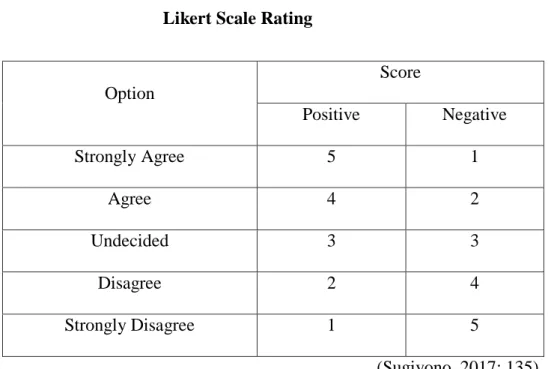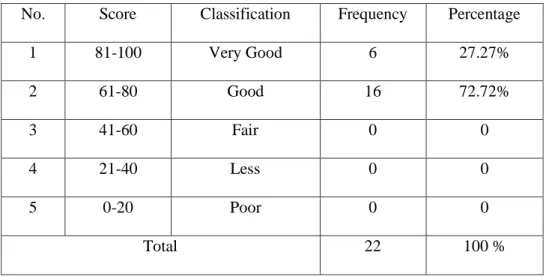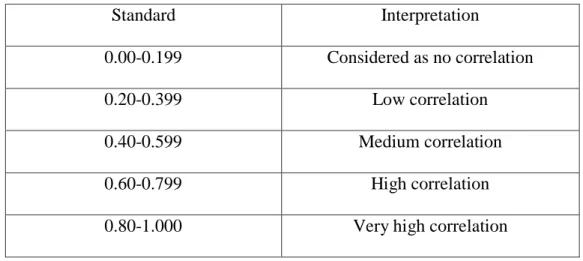This research aimed to find out the learning style of the students and to find out the correlation between the learning style of the students and their achievement in learning English in eleventh grade students of SMA Somba Opu. The instrument used the Student Outcomes and Achievement Questionnaire to measure students' learning style and achievement. The result showed that the most dominant students choose auditory learning style as their learning style, it means that the students' learning style was auditory learning style.
It is also shown that the students' learning style among the eleventh grade students of SMA Somba Opu was very good with the average score was 79. Meanwhile, the average score of students' performance in learning English was 79 as classified as high. It can be concluded that there was low correlation between students' learning style and their performance in English class among the eleventh grade students of SMA Somba Opu in Academic Year 2018/2019.
INTRODUCTION
Problem Statement
What is the learning style of the students in learning English in the eleventh grade of SMA Somba Opu. How is the correlation between students' learning style and their performance in learning English in the eleventh grade of SMA Somba Opu.
Objective of the Study
Significance of the Study
Scope of the Study
In this chapter, we examined the related literature after finding some research information on learning style. The researcher found information from many sources such as textbooks, journals, websites and research findings, which the researcher compiled into selected theories.
Previous Related Research Findings
So that students with different learning styles can also easily accept and understand the subject material presented by the teacher. Pallapu (2007) in his study entitled Effects of Visual and Verbal Learning Styles on Learning found that "learning style differences affect learning and therefore if handled appropriately, there will be a great increase in the achievement of learning outcomes". The results of the research indicated that the majority of the learners were visual and the rest were categorized as verbal.
This study reinforces the importance of meeting individual learners' learning styles in an educational setting, as well as possibilities for instructor awareness and curriculum improvements. Based on the previous research findings, the researcher can conclude that the similarity of the research with previous research is about knowing the types of students' learning style and seeing the students' performance in learning. While the difference is the research location and there is a research that uses Verbal Learning Style as a research object.
Some Pertinent Ideas
- The Concept of Learning
- The Concept of Learning Style
- Learning Style in Learning English (Language)
Another definition of learning style by Kocinski in Soflano and Hainey (2015: 4) is a learner's preferred strategy to perceive, interact and respond to the learning environment. Learning style is described as individualistic differences in approach within the process of receiving and processing information Kolb in Cabi and Serpil. This learning style is closely related to a personality, which is influenced by his upbringing and developmental history.
There have been many researchers who classify learning styles into various types, but the most commonly used is classification referred to in De Porter & Hernacki in Nihayah (2011: 8) who divide learning styles into 3 types: . 1) Visual learning style. The characteristics of students who have a visual learning style was a high need to see and capture the information before understanding it. Students who have a visual learning style capture lessons through visual materials, have a strong sense of color and have adequate understanding of artistic problems.
Characteristics of learning style focus on listening as the primary tool for absorbing information or knowledge. That is, must listen, then can remember and understand certain information. This learning style requires individuals to touch something that provides certain information in order to remember it. Just by holding it, someone with this learning style can absorb information without reading the explanation.
Individuals with this learning style find that they can learn better when the process is accompanied by physical activity. Students' learning styles cannot be changed, but when students understand the learning style that a teacher expects from students, they can increase their own learning style to match that individual's learning style. Teachers must be able to understand each student's learning style so that the material can reach students with different characteristics and learning styles so that the teaching and learning process is effective.
A learning style is a person's tendency to use a certain way of learning in order to learn well.
Conceptual Framework
Research Hyphotesis
RESEARCH METHOD
- Research Variable and Indicators
- Variables
- Indicators
- Population and Sample
- Population
- Sample
- Research Instrument
- Procedure of Collecting the Data
- Research Data Collection
- Questionnaire for Students' Learning Style Variable
- Students' Score Achievement
- Data Analysis Technique
- Descriptive Analysis
- Correlation Analysis
The questionnaire and student performance score were intended to obtain data on students' learning style and performance. This analysis was used to describe each variable in this study, namely student learning style and student performance. To indicate the level of students' learning style and their performance, the researcher used the range category as follows:
This analysis was used to find out the correlation between students. learning style and their performance. The learning style of the students was determined based on the data from the questionnaire. It can be concluded that most of the students claimed that the learning style of the students in the eleventh grade of SMASomba Opu was in a very good condition.
Based on the data of students' learning style and students' achievements, the researcher found the connection between both aspects. It showed that there was positive correlation between students' learning style and students' performance in learning English in the eleventh grade students of SMA Somba Opu. It can therefore be concluded that learning style in the eleventh grade students of SMA Somba Opu was good.
Before analyzing the correlation between students' learning style and students' performance, the researcher collected data from students. From the results of the study, the researcher concluded that there was a low correlation between students' learning style and students' performance in learning English. THE RESULT OF THE STUDENTS LEARNING STYLE QUESTIONNAIRE FOR THE ELEVENTH STUDENTS OF SMA SOMBA OPU.
ASSESSMENT OF LEARNING STYLE OF ELEVENTH SCHOOL STUDENTS OF ŠMA SOMBA OPU.

FINDINGS AND DISCUSSION
Students‟ Learning Style and Students‟
The illustration of the table above shows that there were 7 students Visual Learning Style, 14 students Auditory Learning Style, and 1 student Kinesthetic Learning Style among the eleventh grade students of SMA Somba Opu. The score is taken from the highest block scores, so it is the determining factor of students' learning style. As mentioned in the previous chapter, the researcher took the score of students' performance by students' score performance to 22 students as a sample.
Based on the data collected from the students' performance, the score of the students' performance had been determined. As shown in the table, there were students who were listed as very high achievers and there were students who were listed as high achievers. In conclusion, the students of Eleventh Grade Students of SMA Somba Opu had high achievement in learning English.

The Correlation between Students‟ Learning Style and Their
Based on the data analysis, the researcher found that r-analysis = 0.334, it was on which was interpreted as low correlation.
Discussion
- Learning Style and Students Achievement
- Correlation between Students Learning Style and Their
Based on the sample statistics as displayed in table 4.1, the overall mean score of students' learning style was 79 and classified as "Good". Finally, there were no students who claimed that the learning style was fair, less and poor. According to De Porter and Hernacki, there are three types of learning style which are visual, auditory and kinesthetic.
Finally, questionnaire data was analyzed and calculated to see a significant correlation between students' learning style and their learning performance. The Pearson Product Moment formula was used to find out the learning style of the students and their performance in learning English from the data obtained. This is evident from the outcome of the questionnaire administered to the students in which the auditory learning style was the most dominant learning style.
Based on the explanation in Chapter 2, De Porter and Hernacki also mention the characteristic features of students' auditory learning style, they are: 1) Talk to yourself while working; It also provides suggestions to both teachers and students involved in the teaching and learning process regarding the development of the level of students' learning style and student performance. Based on the result of the questionnaire, the most dominant students choose Auditory learning style as their learning style.
So this can be provided by the students learning style at the Eleventh Grade Students of SMA Somba Opu was Auditory Learning Style. Based on the result of using Pearson Product Moment formula, the researcher found that there was a low correlation between students' learning style and their performance in learning English among the eleventh grade Students of SMA Somba Opu. New college student's teaching preferences and how they relate to learning style and motivational strategies.
Learning Style of Primary Education Prospective Mathematics Teacher; Conditions of trait anxiety and academic success.
CONCLUSIONS AND SUGGESTIONS
Suggestion
For this, the researcher suggests that teachers pay more attention to the students' learning style, especially Auditory Learning Style in the classroom so that students' grades increase when appropriate learning style is applied. The researcher suggests to students when learning is going on, show your ability to adapt to the learning process with learning style that you think is very suitable, so that the results can be what you expect. The researcher suggests to another researcher who wants to know how to determine the students' learning style in relation to the students.
Pengaruh gaya belajar terhadap kinerja belajar pada mata kuliah pelatihan kelistrikan otomotif siswa kelas XI teknik reparasi bodi otomotif di SMKN 2 Depok Sleman. -Berbagai gaya belajar dan. https://nugiesmansulsel.wordpress.com beragam-gaya-belajar-dan-kekurangan-dan-kebesaranya/, diakses 12 Januari 2019).
